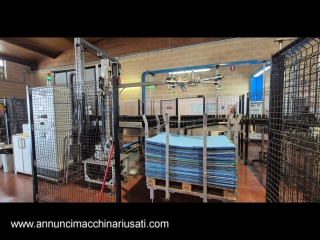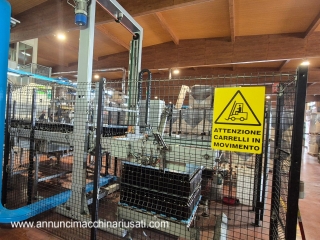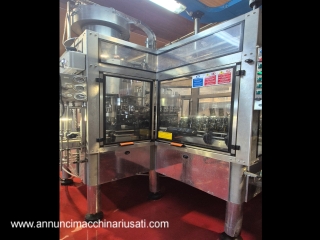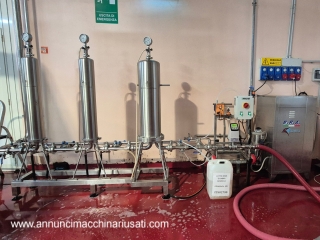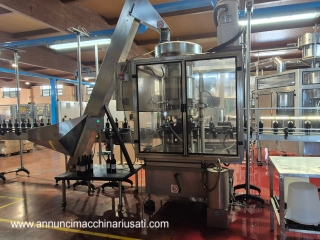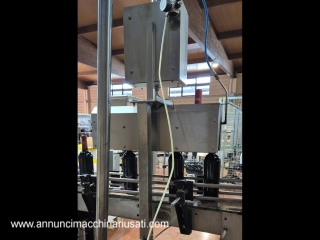Description
Complete Used Isobaric Bottling Line for Still and Sparkling Wines up to 4,500 bottles per hour. This complete bottling line was designed and configured to provide a consistent, high-quality filling process for both still and sparkling wines. Built around an isobaric triblock system, it integrates rinsing, filling, and corking functions in a continuous flow, ensuring excellent efficiency while maintaining product integrity. The line is currently configured for still wines with an output of 4,500 bottles per hour and for sparkling wines with an output of 3,000 bottles per hour. It is already technically configured for sparkling wine production and only requires the addition of a mushroom corker, a capsule applicator for sparkling wine corks, and, if necessary, a heating tunnel. The system is equipped with dedicated conveyor belts, a centralized lubrication system, and separate control panels for conveyor management, allowing for easy maintenance and integration into existing plant automation. The entire layout follows a linear configuration, optimized for space utilization and ensuring smooth product transfer between each stage without unnecessary accumulation points. Bottling process and main machines At the beginning of the line, empty bottles are automatically fed into the system via a depalletizer. This equipment gently lifts and transfers the bottles to the infeed table, maintaining their integrity. The bottles are then directed to the triblock system, where three key operations are performed sequentially: rinsing, filling, and corking. Isobaric filling technology ensures precise fill levels and consistent carbonation retention for sparkling wines, and is also ideal for bottling still wines. The filling valves are designed to minimize oxygen absorption, which is essential for preserving the sensory qualities and shelf life of wine. The rinser operates with clean water or a sanitizing solution, ensuring that bottles are free of contaminants before filling. The corking turret, currently configured for still wine closures, applies both BVS screwcaps and traditional corks, depending on the selected format. A gum arabic dosing unit is integrated into the line. This system allows for the precise addition of stabilizing agents after filling, which helps maintain wine clarity and prevent precipitation during storage. A dedicated steam generator (vapouriser) is included for both line sanitization and, when required, for preheating applications. Before filling, a microfiltration unit is installed to ensure that the product entering the triblock meets the desired microbiological standards. This step is essential to guarantee product stability and quality without the need for excessive chemical preservatives. Downstream, the bottles are transferred to the labeling station. The labeling unit, although supplied by a third-party manufacturer, is electrically integrated into the line and can be configured for various types of labels, including adhesive and cold glue systems. The conveyors are constructed with stainless steel frames and modular belts, are fully washable, and equipped with automatic lubrication points. Power is supplied to each conveyor section via individual drives, and the line control allows for speed synchronization to prevent bottle stress from accumulation. The end-of-line layout includes a future accumulation table, allowing for additional accumulation capacity between the labeling and case packing stations. Although the current scope does not include case packing or palletizing equipment, the 5,000 mm exit height for the conveyor system is compatible with automated end-of-line systems. Formats and handling capacity: The line is versatile and designed to handle a wide range of premium bottle formats. Current format capacity includes: Bordolese Standard TS/BVS Bordolese Conica TS/BVS Conica Elite TS Nobile TS Authentique TS Borgognotta TS Adriatica 1 Liter TS/BVS Arno 1.5 Liter TS Format changeover kits are available for these bottles, allowing the line to be efficiently reconfigured for different product runs. The handling parts are designed to ensure proper centering and stability during the filling and corking process, especially important for taller formats like the Arno 1.5 L. The isobaric filling system is compatible with wines with varying levels of carbonation, from still wines to sparkling wines. Bottle neck handling is adaptable to various closure types, including BVS screw caps, straight caps, and, with additional equipment, mushroom corks for sparkling wine. The conveyor system and starwheels are sized to ensure precise handling, avoiding scratches or breakages. Construction, Automation, and Integration The bottling line is constructed primarily of AISI 304 stainless steel, ensuring corrosion resistance and compliance with the hygiene standards required in the wine industry. All contact parts are made of food-grade materials, and the machine guard is transparent for easy monitoring of operations while maintaining operator safety. The electrical system features separate control cabinets for the conveyors, independent of the main machine PLCs. This separation allows for easy maintenance and minimizes downtime during maintenance. The conveyors are equipped with frequency-controlled drives to allow for speed synchronization across the entire line, ensuring a smooth flow without bottle collisions. A centralized lubrication system supplies critical moving parts, significantly reducing manual maintenance requirements. Safety interlocks are installed on all main access points, in compliance with CE safety standards. The depalletizer, triblock, dosing system, vaporizer, and microfiltration unit are mechanically and electronically integrated, allowing the entire line to be operated from a single control interface. The layout has been optimized for linear flow, with direct transfers between machines and a minimal footprint, while still allowing sufficient access for cleaning and maintenance. This Complete Used Isobaric Bottling Line for Still and Sparkling Wines up to 4,500 bph combines mechanical robustness and operational flexibility. It is suitable for wineries requiring medium-scale production with the ability to switch from still to sparkling wines without significant downtime. The current configuration prioritizes product quality, hygiene, and adaptability to various premium bottle formats, while its structural and automation features make it a reliable and repairable solution for long-term use in a professional wine production environment.



